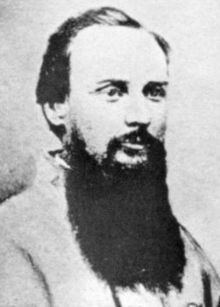Name Samuel Ferguson | ||
 | ||
Born November 3, 1834Charleston, South Carolina ( 1834-11-03 ) Years of service 1857–61 (USA)1861–65 (CSA) Battles/wars Utah WarAmerican Civil War Other work President of the United States Board of Mississippi River CommissionersSecretary and Treasurer of the Mississippi Levee Board Allegiance United States of America, Confederate States of America | ||
Place if burial Greenwood Cemetery | ||
Samuel W. Ferguson (born Samuel Wragg Ferguson; November 3, 1834 – February 3, 1917) was a senior officer of the Confederate States Army who commanded cavalry in the Western Theater of the American Civil War.
Contents
Early life
Ferguson graduated from the United States Military Academy in 1857. Before graduation, he joined Colonel Albert Sidney Johnson's Utah War to fight the Mormons. He then went to St. Louis to join his regiment. After the expedition, he was assigned to Fort Walla Walla in the Washington Territory, where he stayed from 1859 to 1860. This all changed when he received the results of the 1860 presidential election. Hearing of the election of Abraham Lincoln, he immediately resigned and left for Charleston, South Carolina.
American Civil War
In March 1861, Ferguson was commissioned a captain in the South Carolina militia, afterwards being appointed Lieutenant and aide-de-camp to C.S. Brigadier-General P. G. T. Beauregard. He was one of the officers who received the formal surrender of U.S. Major Robert Anderson at Fort Sumter, raised the first Confederate States flag, and posted the first guards at Fort Sumter. After the siege, he was sent to present the first Confederate flag struck by enemy shot to the Provisional Congress of the Confederate States. He was a lieutenant colonel and aide-de-camp to General Beauregard during the Battle of Shiloh. During the Battle of Farmington, he was in the 28th Mississippi Cavalry Regiment. He commanded the unit while defending Vicksburg, and helped stop attacks made by U.S. Major General William T. Sherman and U.S. Commodore David Porter.
On July 28, 1863, Ferguson was promoted to brigadier-general. He was subsequently recommended for promotion to Major-General, but Joseph Wheeler quickly objected. During Sherman's March to the Sea, Ferguson and his cavalrymen harassed the flank of the United States Army. When Sherman got close to Savannah, Ferguson's men left their horses and covered the Confederate retreat. He was then ordered to Danville, Virginia, but before arriving was ordered to go to Charlotte, North Carolina. From Charlotte he escorted Jefferson Davis into Georgia, where his unit was disbanded.
Later life
After the war Ferguson moved to Greenville, Mississippi, where he practiced law. He married Catherine Lee, daughter of Henry William and Eleanor Percy Lee who was a cousin of Robert Edward Lee. In 1876 he was appointed as president of the United States Board of Mississippi River Commissioners. He was also secretary and treasurer of the Mississippi Levee Board. In 1894, twenty thousand to forty thousand dollars mysteriously disappeared from the Mississippi Levee Board, of which Ferguson was both secretary and treasurer. Later that year, he suddenly left and moved to his hometown of Charleston where worked as a civil engineer. After staying in Charleston, Samuel moved to Ecuador. It would be many years before he returned. At the outbreak of the Spanish–American War, he tried to join the war effort but he was turned down. On February 3, 1917, Ferguson died in Jackson, Mississippi, where he is buried at the Greenwood Cemetery along with other famous Confederate generals.
